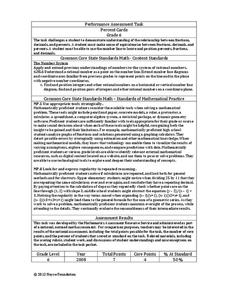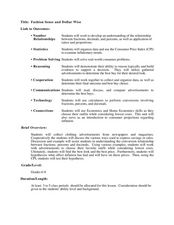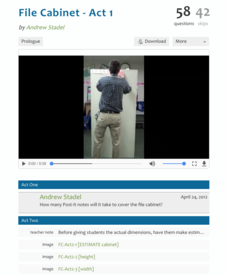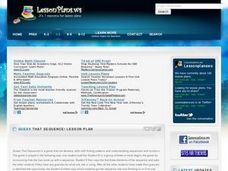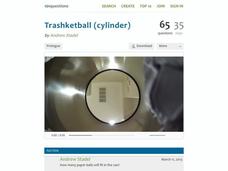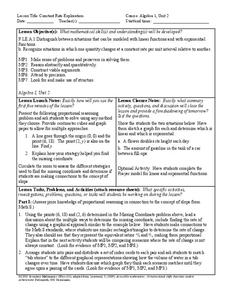Noyce Foundation
Percent Cards
Explore different representations of numbers. Scholars convert between fractions, decimals, and percents, and then use these conversions to plot the values on a horizontal number line.
EngageNY
Estimating Digits in a Quotient
Boiling down any division problem to a one-digit divisor problem sure makes estimation easy. The lesson shows how to estimate division problems by using place value understanding and basic arithmetic facts to simplify the division. Some...
Mathematics Assessment Project
Modeling Motion: Rolling Cups
Connect the size of a rolling cup to the size of circle it makes. Pupils view videos of cups of different sizes rolling in a circle. Using the videos and additional data, they attempt to determine a relationship between cup...
Statistics Education Web
You Will Soon Analyze Categorical Data (Classifying Fortune Cookie Fortunes)
Would you rely on a fortune cookie for advice? The lesson plan first requires future statisticians to categorize 100 fortune cookie fortunes into four types: prophecy, advice, wisdom, and misc. The lesson plan goes on to have learners...
Curated OER
Number Order
In this number sense worksheet, students solve 5 problems that require them to examine 5 sets of 5 numbers and put them in chronological order.
Curated OER
Reading Comprehension Volume 5 Number 10: Simple Math
In this missing words in a text worksheet, learners read an article about the new millennium and the Gregorian calendar. Using a word bank of 4 possible choices for each blank space, students complete the article, filling in ten missing...
Curated OER
Ag In The Outfield
Young scholars explore baseball. This is a cross-curricular plan that includes math, history, and agriculture. Pupils use their five senses to observe the materials a baseball is made from and identify the agricultural products used. In...
Curated OER
Number Sense and Operations
In this math story problem worksheet, students read the 9 story problems and select the correct answer from the 4 choices available. The top of this worksheet indicates that it is appropriate for Grade 5.
Curated OER
Fashion Sense and Dollar Wise
Middle schoolers work in groups to show understanding of the relationship between fractions, decimals, percentages, and the application of ratios and proportions. In this decimals, fractions, and percents lesson, students use real life...
Curated OER
Standard, Expanded and Written Number Form (O)
In this number sense learning exercise, students fill in 14 blanks in a chart with either the standard, expanded, or written form of each of the given numbers. They work with numbers to the hundred thousands place value.
Curated OER
Sea and Learn - Lesson Plan: A Day at the Dockyard
Students illustrate and practice number bonds to 5, 10 and 20. They participate in short warm-up games and then advance to the task related to solving with number bonds. Many strategies of calculation are utilized to help the students...
Curated OER
Making Sense of the Census
Students problem solve the mean and median of agricultural data by completing a worksheet. They discuss the results of the statistical data.
Illustrative Mathematics
Making a Clock
Have a fun time teaching children to read analog clocks with this whole-group math activity. Using large sets of the numerals 1-12 and 0, 5, 10...55, the teacher creates a large clock on either the carpet or the white board, explaining...
T. Smith Publishing
Counting Tools
As the title states, the activity required to complete this worksheet is counting tools! Saws, screwdrivers, and wrenches are depicted for children to count. They simply write the number of items on a line to the right of each group....
College Board
Calculations Aren't Enough!
Unlike mathematics, statistics comes with a context. The author reminds teachers that data analysis involves using the context to make sense of the numbers. The article stresses good communication skills by highlighting the scoring...
101 Questions
File Cabinet
Take the resource out of the file cabinet. Young mathematicians estimate the number of sticky notes it would take to cover the surface area of a file cabinet. They answer a set of questions on how the number of sticky notes would change...
Curated OER
Guess That Sequence!
Young scholars explore number sense by completing problems in class. In this patterns lesson, students examine a group of numbers and identify what the pattern is and how it should correctly continue. Young scholars practice utilizing...
K-5 Math Teaching Resources
Multiplication Chart
This is not your run-of-the-mill multiplication chart. Going beyond the standard 12 x 12 limit, this resource includes multiplication facts up through 12 x 20, making it great for supporting children as they continue working toward being...
101 Questions
Trashketball
Take a shot using a lesson on volume! Young learners watch a video showing a trashcan filling with paper balls. The task is to calculate the number of paper balls that will fit in the can. Pupils use volume calculations to make a...
Curated OER
The Random Walk II
Deep mathematical thinking is found with just a coin and a number line. Combining computing some probabilities in a discrete situation, and the interpretation of a function, this simple task gives learners a lot to think about on...
Howard County Schools
Constant Rate Exploration
Question: What do rectangles and bathtub volume have in common? Answer: Linear equations. Learn how to identify situations that have constant rates by examining two different situations, one proportional and one not proportional.
Curated OER
Subtraction
Students explore subtraction. In this mathematics lesson, students practice how to subtract numbers from 20, 100 and other whole numbers. Students realize that there are number bonds which can help with subtraction like 3 and 17 bonds to...
Curated OER
A-Mazing Facts
In this skip-counting by sevens worksheet, 3rd graders help a mouse find its way through a maze. Students utilize multiplication to find a path where the product is a multiple of seven.
Curated OER
Total Cost and Unit Cost
In this unit rate learning exercise, students solve 6 problems in which the unit rate in a consumer math story problem is calculated. There are no examples or instructions.
